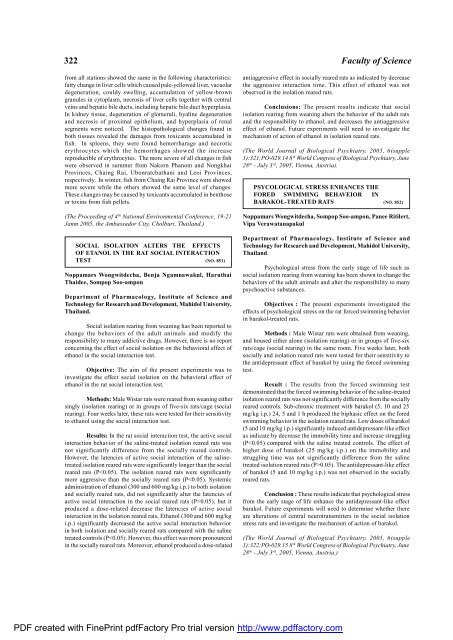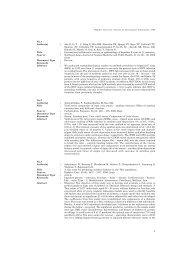Faculty of Science - Mahidol University
Faculty of Science - Mahidol University
Faculty of Science - Mahidol University
You also want an ePaper? Increase the reach of your titles
YUMPU automatically turns print PDFs into web optimized ePapers that Google loves.
322<br />
from all stations showed the same in the following characteristics:<br />
fatty change in liver cells which caused pale-yellowed liver, vacuolar<br />
degeneration, couldy swelling, accumulation <strong>of</strong> yellow-brown<br />
granules in cytoplasm, necrosis <strong>of</strong> liver cells together with central<br />
veins and hepatic bile ducts, including hepatic bile duct hyperplasia.<br />
In kidney tissue, degeneration <strong>of</strong> glomeruli, hyaline degeneration<br />
and necrosis <strong>of</strong> proximal epithelium, and hyperplasia <strong>of</strong> renal<br />
segments were noticed. The histopathological changes found in<br />
both tissues revealed the damages from toxicants accumulated in<br />
fish. In spleens, they were found hemorrharage and necrotic<br />
erythrocytes which the hemorrhages showed the increase<br />
reproducible <strong>of</strong> erythrocytes. The more severe <strong>of</strong> all changes in fish<br />
were observed in summer from Nakorn Phanom and Nongkhai<br />
Provinces, Chaing Rai, Ubonratchathani and Leoi Provinces,<br />
respectively. In winter, fish from Chaing Rai Province were showed<br />
more severe while the others showed the same level <strong>of</strong> changes.<br />
These changes may be caused by toxicants accumulated in benthose<br />
or toxins from fish pellets.<br />
(The Proceeding <strong>of</strong> 4 th National Environmental Conference, 19-21<br />
Janm 2005, the Ambassador City, Cholburi, Thailand.)<br />
SOCIAL ISOLATION ALTERS THE EFFECTS<br />
OF ETANOL IN THE RAT SOCIAL INTERACTION<br />
TEST (NO. 851)<br />
Noppamars Wongwitdecha, Benja Ngamnawakul, Haruthai<br />
Thaidee, Sompop Soo-ampon<br />
Department <strong>of</strong> Pharmacology, Institute <strong>of</strong> <strong>Science</strong> and<br />
Technology for Research and Development, <strong>Mahidol</strong> <strong>University</strong>,<br />
Thailand.<br />
Social isolation rearing from weaning has been reported to<br />
change the behaviors <strong>of</strong> the adult animals and modify the<br />
responsibility to many addictive drugs. However, there is no report<br />
concerning the effect <strong>of</strong> social isolation on the behavioral effect <strong>of</strong><br />
ethanol in the social interaction test.<br />
Objective: The aim <strong>of</strong> the present experiments was to<br />
investigate the effect social isolation on the behavioral effect <strong>of</strong><br />
ethanol in the rat social interaction test.<br />
Methods: Male Wistar rats were reared from weaning either<br />
singly (isolation rearing) or in groups <strong>of</strong> five-six rats/cage (social<br />
rearing). Four weeks later, these rats were tested for their sensitivity<br />
to ethanol using the social interaction test.<br />
Results: In the rat social interaction test, the active social<br />
interaction behavior <strong>of</strong> the saline-treated isolation reared rats was<br />
not significantly difference from the socially reared controls.<br />
However, the latencies <strong>of</strong> active social interaction <strong>of</strong> the salinetreated<br />
isolation reared rats were significantly longer than the social<br />
reared rats (P
















